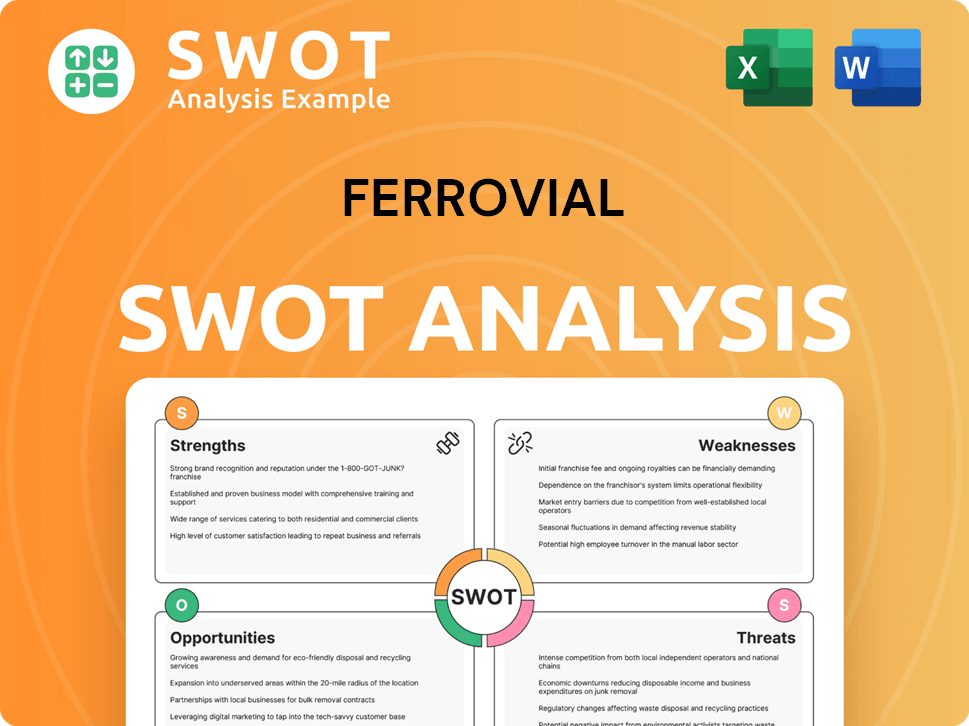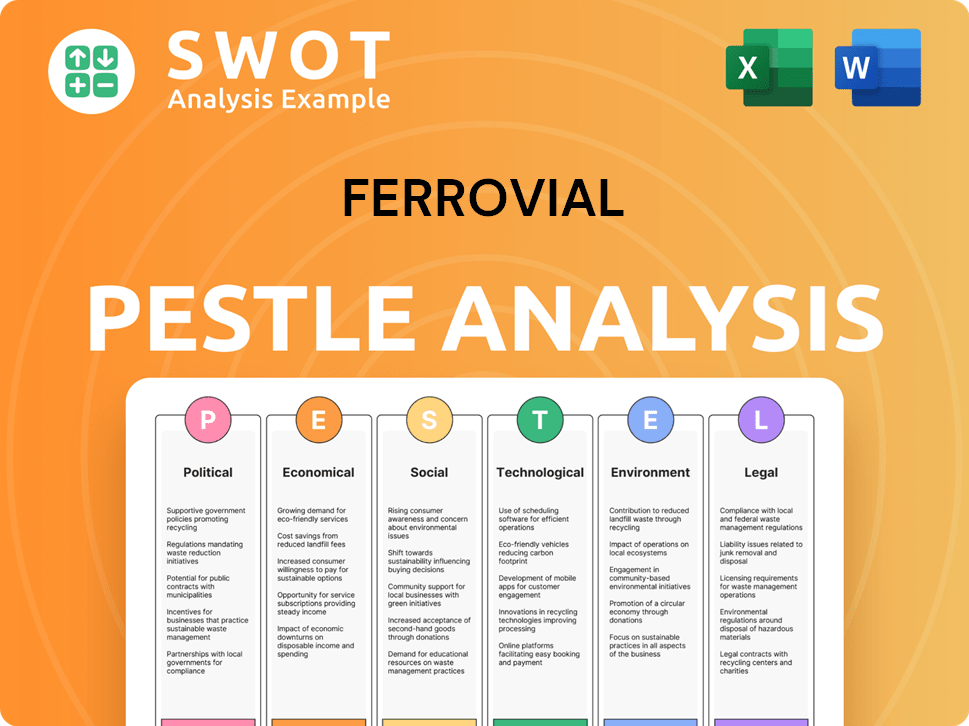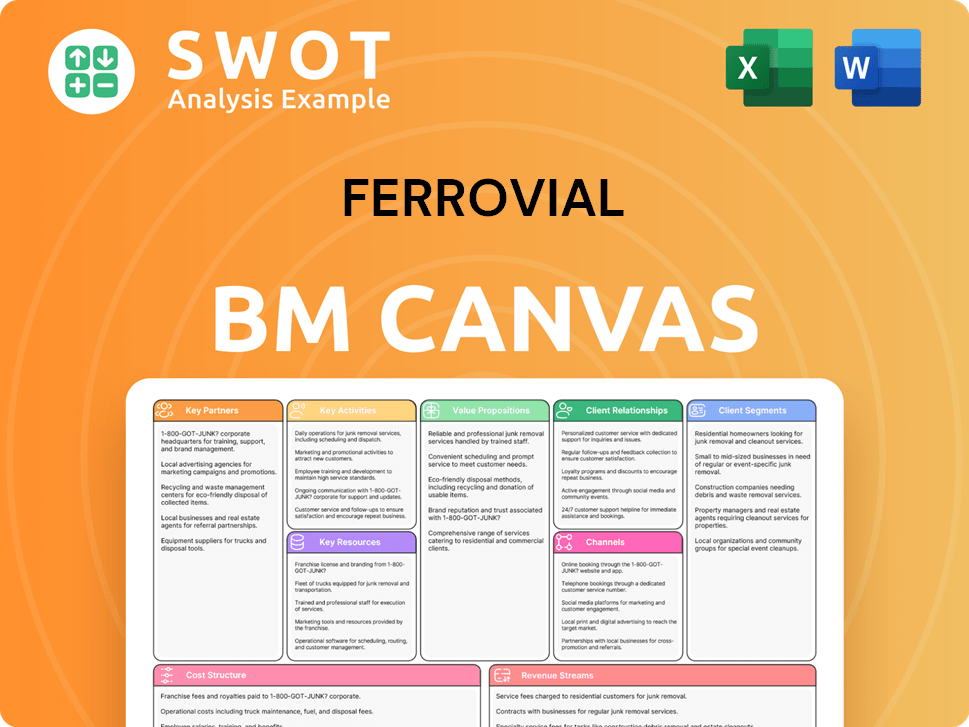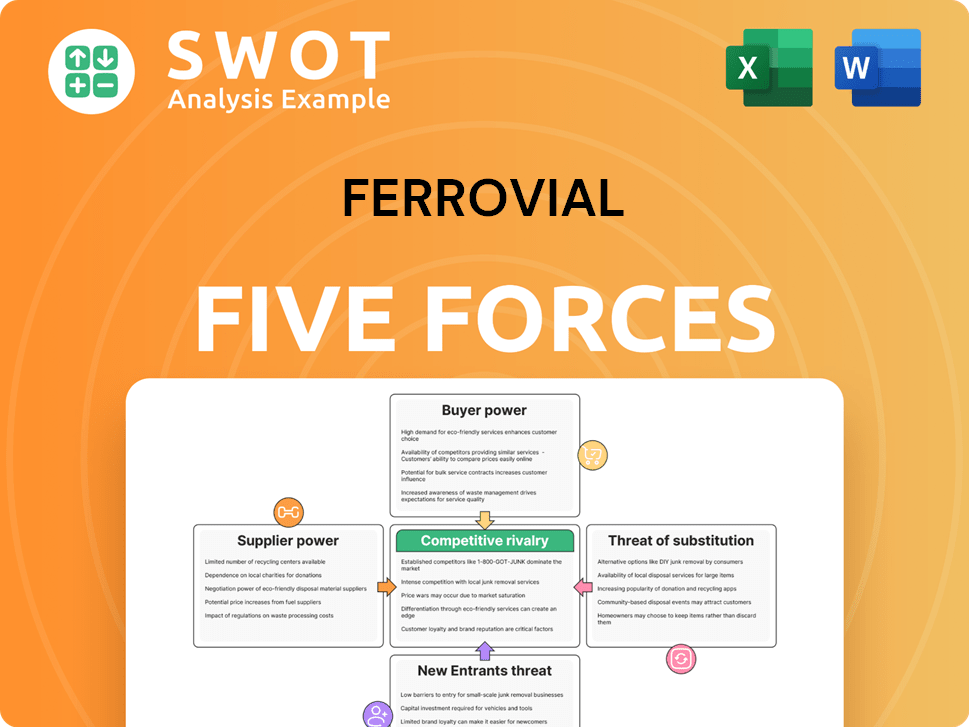Ferrovial Bundle
How Does Ferrovial Stack Up in the Infrastructure Arena?
The infrastructure sector is a battlefield of innovation and strategic maneuvering, and Ferrovial is right in the thick of it. This global leader is constantly adapting to meet the complex needs of modern societies. But who are its main rivals, and how does Ferrovial maintain its competitive edge?

To truly understand Ferrovial's position, we must delve into its Ferrovial SWOT Analysis and the broader Ferrovial competitive landscape. This deep dive will explore the Ferrovial competitors it faces, providing a detailed Ferrovial market analysis to reveal the key differentiators that drive its success. We'll examine Ferrovial's business strategy and financial performance compared to its rivals, offering insights into its global presence and strategic partnerships within the Ferrovial industry.
Where Does Ferrovial’ Stand in the Current Market?
Ferrovial maintains a strong market position within the global infrastructure industry. The company's core operations revolve around the design, construction, financing, and operation of infrastructure assets, including toll roads, airports, and construction projects. This diversified approach allows Ferrovial to capture value across the infrastructure lifecycle.
The value proposition of Ferrovial lies in its ability to deliver high-quality infrastructure projects, coupled with a focus on long-term asset management. This strategy is supported by a robust financial performance and a commitment to sustainable practices. Ferrovial's strategic focus on asset development and management, particularly in high-value, long-term concessions, further solidifies its market position.
In 2023, Ferrovial reported total revenues of €8,514 million, a 12.7% increase compared to the previous year. This growth indicates the company's strong financial performance and its ability to secure and execute projects. The company's EBITDA reached €989 million, showcasing healthy operational profitability.
Ferrovial has a significant global presence, with a strong foothold in North America (47% of revenue in 2023) and Europe (41% of revenue). The company's strategic focus on key markets allows it to diversify its revenue streams and mitigate risks. Ferrovial's international expansion is a key part of its business strategy.
Ferrovial's financial health is robust, as demonstrated by its net cash position from continuing operations (excluding infrastructure project finance debt) of €1,466 million as of December 31, 2023. This strong financial standing supports the company's ability to invest in future projects and pursue strategic opportunities. For a more detailed overview, consider reading the Brief History of Ferrovial.
Ferrovial strategically emphasizes asset development and management, particularly in high-value, long-term concessions. This includes significant investments in toll roads and airports, such as its stakes in Heathrow Airport and the I-66 Express Lanes in Virginia, USA. This focus allows Ferrovial to generate stable, long-term revenue streams.
Ferrovial's competitive landscape is shaped by its strong market position in the North American toll road market and the European airport sector. The company's ability to secure and manage large-scale infrastructure projects gives it a significant advantage. Ferrovial's commitment to sustainable infrastructure also aligns with global trends.
- Strong presence in key markets: North America and Europe.
- Focus on asset development and long-term concessions.
- Robust financial performance and net cash position.
- Commitment to sustainable infrastructure.
Ferrovial SWOT Analysis
- Complete SWOT Breakdown
- Fully Customizable
- Editable in Excel & Word
- Professional Formatting
- Investor-Ready Format

Who Are the Main Competitors Challenging Ferrovial?
The Owners & Shareholders of Ferrovial operates within a highly competitive global infrastructure market. A thorough Ferrovial market analysis reveals a landscape shaped by both direct and indirect competitors vying for projects and market share. Understanding the Ferrovial competitive landscape is crucial for assessing its strategic positioning and future growth prospects.
Ferrovial industry faces challenges from established players and emerging innovators. The competitive dynamics are influenced by factors like project size, geographical focus, technological advancements, and financial capabilities. Analyzing Ferrovial key rivals and their strategies provides valuable insights into the competitive environment.
Ferrovial business strategy involves navigating a complex web of competitors. The company's ability to secure projects, manage costs, and innovate determines its Ferrovial financial performance relative to its peers. The competitive landscape constantly evolves due to mergers, acquisitions, and shifts in market demand.
Direct competitors include major construction and infrastructure development companies. These firms compete with Ferrovial for large-scale projects in various sectors, such as civil engineering, construction, and concessions. Understanding their strengths and strategies is vital for Ferrovial's market positioning.
ACS Group is a significant Spanish competitor, involved in civil engineering, industrial services, and concessions. ACS often competes for similar PPP projects. In 2023, ACS Group reported revenues of approximately €36.5 billion, highlighting its substantial financial capacity and global presence.
Vinci, a French company, is a key competitor in airports, toll roads, and construction. It has a strong presence in Europe and is expanding internationally. Vinci's 2023 revenue reached around €68.8 billion, demonstrating its extensive operational scale and market influence.
Bouygues, another French company, competes with Ferrovial in construction and other sectors like energy and telecommunications. Bouygues reported revenues of approximately €50.7 billion in 2023, showing its diversified business model and competitive reach.
Hochtief, a German construction company largely owned by ACS, is a major player in international projects, particularly in North America through Turner Construction and in Australia through CIMIC. Hochtief's strategic alliances and global network pose a significant competitive challenge.
Indirect competitors include specialized firms and emerging players in specific segments. These companies offer innovative solutions and challenge Ferrovial's market position in areas like airport operations, urban mobility, and renewable energy infrastructure.
The infrastructure market is characterized by intense competition, requiring strategic adaptation. Ferrovial's strengths and weaknesses compared to competitors are crucial for assessing its ability to maintain or improve its market position. Ferrovial bidding strategies analysis is essential to understand how it approaches projects.
- Ferrovial global presence competitors: Competitors' geographical reach influences project opportunities.
- Ferrovial recent acquisitions and their impact on competition: Acquisitions can shift market share and alter competitive dynamics.
- Ferrovial sustainable infrastructure initiatives competitors: Sustainability is an increasingly important factor.
- Ferrovial international expansion competitive challenges: Expanding into new markets involves navigating new competitive landscapes.
Ferrovial PESTLE Analysis
- Covers All 6 PESTLE Categories
- No Research Needed – Save Hours of Work
- Built by Experts, Trusted by Consultants
- Instant Download, Ready to Use
- 100% Editable, Fully Customizable

What Gives Ferrovial a Competitive Edge Over Its Rivals?
The competitive landscape for Ferrovial is shaped by its strategic strengths, including its integrated approach to infrastructure projects and a robust financial foundation. The company's ability to manage projects from design and construction to financing and operation sets it apart. This comprehensive approach allows for greater efficiency and long-term value creation, which is critical in the Ferrovial industry.
Ferrovial's financial health, illustrated by its substantial revenues and EBITDA, supports large-scale investments and strategic acquisitions. The company's global presence and diversified portfolio across toll roads, airports, and construction further mitigate risks, providing a stable revenue base. The company's reputation for delivering high-profile projects, such as the I-66 Express Lanes, enhances its brand equity.
Innovation and sustainability are also key differentiators for Ferrovial. The company leverages proprietary technologies and innovative solutions in areas like smart infrastructure. Its commitment to environmentally friendly infrastructure aligns with market demand and regulatory pressures, giving it a competitive edge. To understand more about the firm's approach to marketing and its overall strategy, you can explore the Marketing Strategy of Ferrovial.
Ferrovial has a history of successfully managing complex, high-profile projects, enhancing its brand equity and reputation. The company's involvement in major infrastructure projects, such as the I-66 Express Lanes in Virginia and Heathrow Airport, showcases its capabilities. These projects demonstrate Ferrovial's ability to deliver quality and reliability.
Ferrovial focuses on innovation and sustainability, particularly in smart infrastructure and sustainable materials. The company is progressively shifting towards an asset-light model in some areas while strengthening its position as a long-term asset manager. These strategic moves support Ferrovial's long-term growth and market position.
Ferrovial's financial strength, as demonstrated by its substantial revenues, allows for large-scale investments and strategic acquisitions. Its global presence and diversified portfolio across various geographies and asset classes mitigate risks. The company's commitment to sustainable infrastructure aligns with growing market demand.
In 2023, Ferrovial reported a strong financial performance, reflecting its robust position in the market. The company's revenue and EBITDA figures highlight its financial stability. These figures demonstrate Ferrovial's ability to secure new concessions and attract talent.
Ferrovial's competitive advantages include its extensive experience in the full infrastructure lifecycle and its strong financial position. Its global presence and diversified portfolio across various geographies and asset classes provide a stable revenue base. The company's commitment to innovation and sustainability differentiates it from competitors.
- Integrated Approach: Expertise in design, construction, financing, and operation.
- Financial Strength: Substantial revenues and healthy EBITDA enable large-scale investments.
- Global Presence: Diversified portfolio across various geographies and asset classes.
- Innovation: Proprietary technologies and solutions in smart infrastructure and sustainable materials.
Ferrovial Business Model Canvas
- Complete 9-Block Business Model Canvas
- Effortlessly Communicate Your Business Strategy
- Investor-Ready BMC Format
- 100% Editable and Customizable
- Clear and Structured Layout

What Industry Trends Are Reshaping Ferrovial’s Competitive Landscape?
The competitive landscape for infrastructure companies like Ferrovial is shaped by evolving industry trends, presenting both challenges and opportunities. A detailed Ferrovial market analysis reveals the need to adapt to sustainability demands, technological advancements, and geopolitical shifts. Understanding the Ferrovial competitive landscape is crucial for strategic planning and ensuring long-term growth in a dynamic market.
Key risks include economic volatility, regulatory changes, and project complexities, while opportunities arise from urbanization, emerging markets, and technological innovation. A robust Ferrovial business strategy must address these factors to maintain a strong position. The company's financial performance is closely tied to its ability to navigate these challenges and leverage emerging opportunities.
The infrastructure industry is experiencing a surge in demand for sustainable and resilient projects, driven by climate change concerns. Digitalization, including BIM and AI, is transforming project design, construction, and operation, enhancing efficiency. Urbanization and population growth continue to fuel the need for new transportation and urban development solutions.
Increased project complexity, land acquisition issues, and innovative financing models pose significant challenges. Geopolitical shifts and economic volatility can impact project pipelines and material costs. Stringent environmental regulations and public demand for transparency require robust governance and stakeholder engagement.
Emerging markets with infrastructure deficits offer substantial growth potential. Strategic partnerships for large-scale projects and diversification into sectors like smart cities present opportunities. Technological advancements and sustainable practices offer avenues for competitive advantage.
Focusing on technology-driven solutions and sustainable practices is crucial. Forming strategic alliances and expanding into new markets can enhance resilience. Adapting to stricter environmental regulations and embracing digital transformation are essential for long-term competitiveness.
The Ferrovial competitors include ACS, Vinci, and Hochtief, each with distinct strengths and strategies. ACS, for instance, reported a revenue of approximately €36.6 billion in 2023, highlighting its significant scale. Vinci's revenue in 2023 reached around €68.8 billion, demonstrating its broad market presence. These companies compete across various infrastructure projects, from transportation to energy. Understanding these Ferrovial key rivals and their strategies is crucial for market positioning.
- Ferrovial vs ACS comparison reveals that ACS has a strong presence in North America, while Ferrovial has a more diversified geographic footprint.
- Ferrovial construction industry rivals are investing heavily in sustainable infrastructure projects to meet growing demand and regulatory requirements.
- Companies are increasingly focusing on digital technologies, such as BIM and AI, to improve efficiency and reduce costs, as seen in recent industry reports.
- Strategic partnerships and acquisitions are common strategies to expand market share and capabilities, as demonstrated by recent industry activities.
For a detailed look at the ideal customer base, consider reading about the Target Market of Ferrovial.
Ferrovial Porter's Five Forces Analysis
- Covers All 5 Competitive Forces in Detail
- Structured for Consultants, Students, and Founders
- 100% Editable in Microsoft Word & Excel
- Instant Digital Download – Use Immediately
- Compatible with Mac & PC – Fully Unlocked

Related Blogs
- What are Mission Vision & Core Values of Ferrovial Company?
- What is Growth Strategy and Future Prospects of Ferrovial Company?
- How Does Ferrovial Company Work?
- What is Sales and Marketing Strategy of Ferrovial Company?
- What is Brief History of Ferrovial Company?
- Who Owns Ferrovial Company?
- What is Customer Demographics and Target Market of Ferrovial Company?
Disclaimer
All information, articles, and product details provided on this website are for general informational and educational purposes only. We do not claim any ownership over, nor do we intend to infringe upon, any trademarks, copyrights, logos, brand names, or other intellectual property mentioned or depicted on this site. Such intellectual property remains the property of its respective owners, and any references here are made solely for identification or informational purposes, without implying any affiliation, endorsement, or partnership.
We make no representations or warranties, express or implied, regarding the accuracy, completeness, or suitability of any content or products presented. Nothing on this website should be construed as legal, tax, investment, financial, medical, or other professional advice. In addition, no part of this site—including articles or product references—constitutes a solicitation, recommendation, endorsement, advertisement, or offer to buy or sell any securities, franchises, or other financial instruments, particularly in jurisdictions where such activity would be unlawful.
All content is of a general nature and may not address the specific circumstances of any individual or entity. It is not a substitute for professional advice or services. Any actions you take based on the information provided here are strictly at your own risk. You accept full responsibility for any decisions or outcomes arising from your use of this website and agree to release us from any liability in connection with your use of, or reliance upon, the content or products found herein.